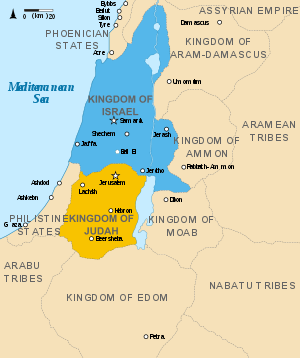Solomon
Solomon (/ˈsɒləmən/; Hebrew: שְׁלֹמֹה, Shlomoh),[lower-alpha 1] also called Jedidiah (Hebrew יְדִידְיָהּ Yedidyah), was, according to the Hebrew Bible, Old Testament,[3] Quran, and Hadiths, a fabulously wealthy and wise king of the United Kingdom of Israel who succeeded his father, King David.[4] The conventional dates of Solomon's reign are about 970 to 931 BCE, normally given in alignment with the dates of David's reign. He is described as king of the United Monarchy, which broke apart into the northern Kingdom of Israel and the southern Kingdom of Judah shortly after his death. Following the split, his patrilineal descendants ruled over Judah alone.[5]
| Solomon | |
|---|---|
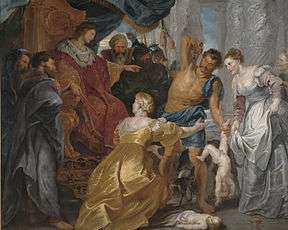 The Judgment of Solomon, 1617 by Peter Paul Rubens (1577–1640) | |
| King of Israel | |
| Reign | c. 970–931 BCE |
| Predecessor | David |
| Successor | Rehoboam |
| Born | c. 990 BCE Jerusalem, United Kingdom of Israel |
| Died | c. 931 BCE Jerusalem |
| Burial | Jerusalem |
| Spouse | Naamah, Pharaoh's Daughter 700 wives of royal birth and 300 concubines[1][2] |
| Issue | |
| House | House of David |
| Father | David |
| Mother | Bathsheba |
According to the Talmud, Solomon is one of the 48 prophets.[6] In the Quran, he is considered a major prophet, and Muslims generally refer to him by the Arabic variant Sulayman, son of David.
The Hebrew Bible identifies him as the builder of the First Temple in Jerusalem,[4] beginning in the fourth year of his reign, using the vast wealth he and his father had accumulated. He dedicated the temple to Yahweh, the God of Israel.[7] He is portrayed as great in wisdom, wealth and power beyond either of the previous kings of the country, but also as a king who sinned. His sins included idolatry, marrying foreign women and, ultimately, turning away from Yahweh, and they led to the kingdom's being torn in two during the reign of his son Rehoboam.
Solomon is the subject of many other later references and legends, most notably in the 1st century apocryphal work known as the Testament of Solomon. In the New Testament, he is portrayed as a teacher of wisdom excelled by Jesus,[8] and as arrayed in glory, but excelled by "the lilies of the field".[9] In later years, in mostly non-biblical circles, Solomon also came to be known as a magician and an exorcist, with numerous amulets and medallion seals dating from the Hellenistic period invoking his name.[10]
Biblical account
The life of Solomon is primarily described in 2 Samuel, 1 Kings and 2 Chronicles. His two names mean "peaceful" and "friend of God", both considered "predictive of the character of his reign".[11]
Chronology
The conventional dates of Solomon's reign are derived from biblical chronology and are set from about 970 to 931 BCE.[12] Regarding the Davidic dynasty, to which King Solomon belongs, its chronology can be checked against datable Babylonian and Assyrian records at a few points, and these correspondences have allowed archaeologists to date its kings in a modern framework. According to the most widely used chronology, based on that by Old Testament professor Edwin R. Thiele, the death of Solomon and the division of his kingdom would have occurred in the spring of 931 BCE.[13]
Childhood
Solomon was born in Jerusalem,[14] the second born child of David and his wife Bathsheba, widow of Uriah the Hittite. The first child (unnamed in that account), a son conceived adulterously during Uriah's lifetime, had died as a punishment on account of the death of Uriah by David's order. Solomon had three named full brothers born to Bathsheba: Nathan, Shammua, and Shobab,[15] besides six known older half-brothers born of as many mothers.[16]
The biblical narrative shows that Solomon served as a peace offering between God and David, due to his adulterous relationship with Bathsheba. In an effort to hide this sin, for example, he sent the woman's husband to battle, hoping that he would be killed there. After he died, David was finally able to marry his wife. As punishment, the first child, who was conceived during the adulterous relationship, died.[17] Solomon was born after David was forgiven. It is this reason why his name, which means peace, was chosen. Some historians cited that Nathan the Prophet brought up Solomon as his father was busy governing the realm.[18] This could also be attributed to the notion that the prophet held great influence over David because he knew of his adultery, which was considered a grievous offense under the Mosaic Law.[19]
Succession and administration
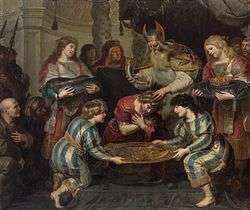
According to the First Book of Kings, when David was old, "he could not get warm".[20] "So they sought a beautiful young woman throughout all the territory of Israel, and found Abishag the Shunamite, and brought her to the king. The young woman was very beautiful, and she was of service to the king and attended to him, but the king knew her not."[20]
While David was in this state, court factions were maneuvering for power. David's heir apparent, Adonijah, acted to have himself declared king, but was outmaneuvered by Bathsheba and the prophet Nathan, who convinced David to proclaim Solomon king according to his earlier promise (not recorded elsewhere in the biblical narrative),[21] despite Solomon's being younger than his brothers.
Solomon, as instructed by David, began his reign with an extensive purge, including his father's chief general, Joab, among others, and further consolidated his position by appointing friends throughout the administration, including in religious positions as well as in civic and military posts.[22] It is said that Solomon ascended to the throne when he was only about fifteen.[23]
Solomon greatly expanded his military strength, especially the cavalry and chariot arms. He founded numerous colonies, some of which doubled as trading posts and military outposts.
Trade relationships were a focus of his administration. In particular he continued his father's very profitable relationship with the Phoenician king Hiram I of Tyre (see 'wealth' below); they sent out joint expeditions to the lands of Tarshish and Ophir to engage in the trade of luxury products, importing gold, silver, sandalwood, pearls, ivory, apes and peacocks. Solomon is considered the most wealthy of the Israelite kings named in the Bible.
Wisdom
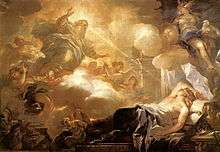
Solomon was the biblical king most famous for his wisdom. In 1 Kings he sacrificed to God, and God later appeared to him in a dream,[24] asking what Solomon wanted from God. Solomon asked for wisdom. Pleased, God personally answered Solomon's prayer, promising him great wisdom because he did not ask for self-serving rewards like long life or the death of his enemies.
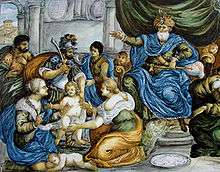
Perhaps the best known story of his wisdom is the Judgment of Solomon; two women each lay claim to being the mother of the same child. Solomon easily resolved the dispute by commanding the child to be cut in half and shared between the two. One woman promptly renounced her claim, proving that she would rather give the child up than see it killed. Solomon declared the woman who showed compassion to be the true mother, entitled to the whole child.[25]
Solomon was traditionally considered the author of several biblical books, "including not only the collections of Proverbs, but also of Ecclesiastes and the Song of Solomon and the later apocryphal book the Wisdom of Solomon."[26]
Wealth
According to the Hebrew Bible, the Israelite monarchy gained its highest splendour and wealth during Solomon's reign of 40 years. In a single year, according to 1 Kings 10:14, Solomon collected tribute amounting to 666 talents (18,125 kilograms) of gold. Solomon is described as surrounding himself with all the luxuries and the grandeur of an Eastern monarch, and his government prospered. He entered into an alliance with Hiram I, king of Tyre, who in many ways greatly assisted him in his numerous undertakings.
Construction projects
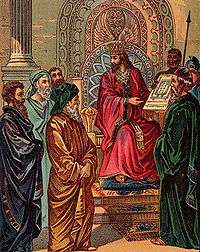
For some years before his death, David was engaged in collecting materials for building a temple in Jerusalem as a permanent home for Yahweh and the Ark of the Covenant. Solomon is described as undertaking the construction of the temple, with the help of an architect, also named Hiram, and other materials, sent from King Hiram of Tyre.
After the completion of the temple, Solomon is described in the biblical narrative as erecting many other buildings of importance in Jerusalem. For 13 years, he was engaged in the building of a royal palace on Ophel (a hilly promontory in central Jerusalem). This complex included buildings referred to as:
- The House (or Hall) of the Forest of Lebanon [27]
- The Hall or Porch of Pillars
- The Hall of the Throne or the Hall of Justice
as well as his own residence and a residence for his wife, Pharaoh's daughter.[28]
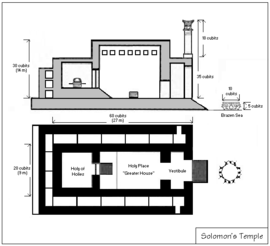
Solomon's throne is said to have been a spectacle, seeing that it was one of the earliest mechanical devices built by man. Solomon also constructed great works for the purpose of securing a plentiful supply of water for the city, and the Millo (Septuagint, Acra) for the defense of the city. However, excavations of Jerusalem have shown a distinct lack of monumental architecture from the era, and no remains of either the Temple or Solomon's palace have been found.
Solomon is also described as rebuilding cities elsewhere in Israel, creating the port of Ezion-Geber, and constructing Palmyra in the wilderness as a commercial depot and military outpost. Although the location of the port of Ezion-Geber is known, no remains have ever been found. More archaeological success has been achieved with the major cities Solomon is said to have strengthened or rebuilt, for example, Hazor, Megiddo and Gezer.[29] These all have substantial ancient remains, including impressive six-chambered gates, and ashlar palaces; however it is no longer the scholarly consensus that these structures date to the time, according to the Bible, when Solomon ruled.[30]
According to the Bible, during Solomon's reign, Israel enjoyed great commercial prosperity, with extensive traffic being carried on by land with Tyre, Egypt, and Arabia, and by sea with Tarshish, Ophir, and South India.
Wives and concubines
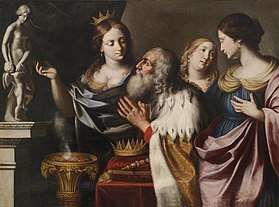
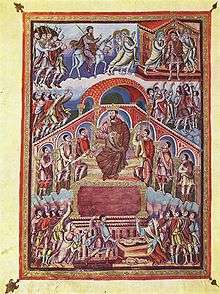
According to the biblical account, Solomon had 700 wives and 300 concubines.[31] The wives were described as foreign princesses, including Pharaoh's daughter [32] and women of Moab, Ammon, Edom, Sidon and of the Hittites. His marriage to Pharaoh's daughter appears to have cemented a political alliance with Egypt, whereas he clung to his other wives and concubines "in love".[33][34] The Message, a biblical paraphrase, says that Solomon was "obsessed with women".[35]
The only wife mentioned by name is Naamah the Ammonite, mother of Solomon's successor, Rehoboam. The biblical narrative notes with disapproval that Solomon permitted his foreign wives to import their national deities, building temples to Ashtoreth and Milcom.[36]
In the branch of literary analysis that examines the Bible, called higher criticism, the story of Solomon falling into idolatry by the influence of Pharaoh's daughter and his other foreign wives is "customarily seen as the handiwork of the 'deuteronomistic historian(s)'", who are held to have written, compiled, or edited texts to legitimize the reforms of Hezekiah's great-grandson, King Josiah who reigned from about 641 to 609 BCE (over 280 years after Solomon's death according to Bible scholars).[37] Scholarly consensus in this field holds that "Solomon's wives/women were introduced in the 'Josianic' (customarily Dtr) edition of Kings as a theological construct to blame the schism [between Judah and the Northern Kingdom of Israel] on his misdeeds".[37]
Relationship with Queen of Sheba
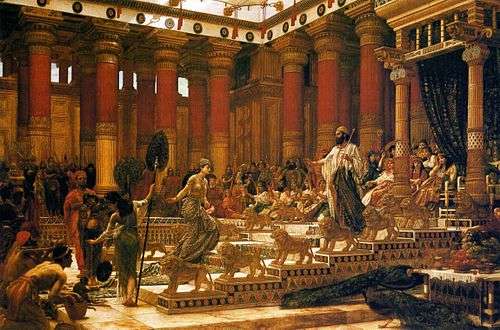
In a brief, unelaborated, and enigmatic passage, the Hebrew Bible describes how the fame of Solomon's wisdom and wealth spread far and wide, so much so that the queen of Sheba decided that she should meet him. The queen is described as visiting with a number of gifts including gold, spices and precious stones. When Solomon gave her "all her desire, whatsoever she asked", she left satisfied (1 Kings 10:10).
Whether the passage is simply to provide a brief token, foreign witness of Solomon's wealth and wisdom, or whether there is meant to be something more significant to the queen's visit is unknown; nevertheless the visit of the Queen of Sheba has become the subject of numerous stories.
Sheba is typically identified as Saba, a nation once spanning the Red Sea on the coasts of what are now Eritrea, Somalia, Ethiopia and Yemen, in Arabia Felix; although other sources place it in the area of what is now northern Ethiopia and Eritrea.[38][39] In a Rabbinical account (e.g. Targum Sheni), Solomon was accustomed to ordering the living creatures of the world to dance before him (Rabbinical accounts say that Solomon had been given control over all living things by Yahweh), but one day upon discovering that the mountain-cock or hoopoe (Aramaic name: nagar tura) was absent, he summoned it to him, and the bird told him that it had been searching for somewhere new (see: Colloquy of the Queen of Sheba).
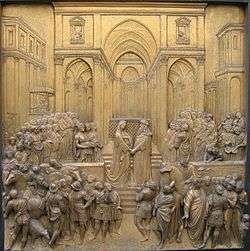
The bird had discovered a land in the east, exceedingly rich in gold, silver, and plants, whose capital was called Kitor and whose ruler was the Queen of Sheba, and the bird, on its own advice, was sent by Solomon to request the queen's immediate attendance at Solomon's court.
An Ethiopian account from the 14th century (Kebra Nagast) maintains that the Queen of Sheba had sexual relations with King Solomon and gave birth by the Mai Bella stream in the province of Hamasien, Eritrea. The Ethiopian tradition has a detailed account of the affair. The child was a son who went on to become Menelik I, King of Axum, and founded a dynasty that would reign as the first Jewish, then Christian Empire of Ethiopia for 2,900+ years (less one usurpation episode, an interval of about 133 years until a legitimate male heir regained the crown) until Haile Selassie was overthrown in 1974. Menelik was said to be a practicing Jew who was given a replica of the Ark of the Covenant by King Solomon; and, moreover, that the original was switched and went to Axum with him and his mother, and is still there, guarded by a single priest charged with caring for the artifact as his life's task.
The claim of such a lineage and of possession of the Ark has been an important source of legitimacy and prestige for the Ethiopian monarchy throughout the many centuries of its existence, and had important and lasting effects on Ethiopian culture as a whole. The Ethiopian government and church deny all requests to view the alleged ark.[lower-alpha 2]
Some classical-era Rabbis, attacking Solomon's moral character, have claimed instead that the child was an ancestor of Nebuchadnezzar II, who destroyed Solomon's temple some 300 years later.[40]
Sins and punishment
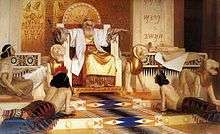
According to 1 Kings 11:4 Solomon's "wives turned his heart after other gods", their own national deities, to whom Solomon built temples, thus incurring divine anger and retribution in the form of the division of the kingdom after Solomon's death (1 Kings 11:9–13). 1 Kings 11 describes Solomon's descent into idolatry, particularly his turning after Ashtoreth, the goddess of the Sidonians, and after Milcom, the abomination of the Ammonites. In Deuteronomy 17:16–17, a king is commanded not to multiply horses or wives, neither greatly multiply to himself gold or silver. Solomon sins in all three of these areas. Solomon collects 666 talents of gold each year (1 Kings 10:14), a huge amount of money for a small nation like Israel. Solomon gathers a large number of horses and chariots and even brings in horses from Egypt. Just as Deuteronomy 17 warns, collecting horses and chariots takes Israel back to Egypt. Finally, Solomon marries foreign women, and these women turn Solomon to other gods.
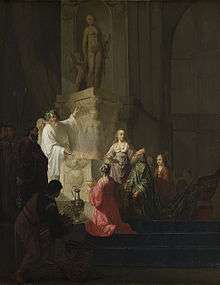
According to 1 Kings 11:30–34 and 1 Kings 11:9–13, it was because of these sins that the Lord punishes Solomon by removing most of the Tribes of Israel from rule by Solomon's house.[41]
And the Lord was angry with Solomon, because his heart had turned away from the Lord, the God of Israel, who had appeared to him twice and had commanded him concerning this thing, that he should not go after other gods. But he did not keep what the Lord commanded. Therefore the Lord said to Solomon, "Since this has been your practice and you have not kept my covenant and my statutes that I have commanded you, I will surely tear the kingdom from you and will give it to your servant. Yet for the sake of David your father I will not do it in your days, but I will tear it out of the hand of your son. However, I will not tear away all the kingdom, but I will give one tribe to your son, for the sake of David my servant and for the sake of Jerusalem that I have chosen.
Enemies
Near the end of his life, Solomon was forced to contend with several enemies, including Hadad of Edom, Rezon of Zobah, and one of his officials named Jeroboam who was from the tribe of Ephraim.
Death, succession of Rehoboam, and kingdom division
According to the Hebrew Bible, Solomon is the last ruler of a united Kingdom of Israel. After a reign of forty years, he dies of natural causes[42] at around 60 years of age. Upon Solomon's death, his son, Rehoboam, succeeds him. However, ten of the Tribes of Israel refuse to accept him as king, splitting the United Monarchy in the northern Kingdom of Israel under Jeroboam, while Rehoboam continues to reign over the much smaller southern Kingdom of Judah. Henceforth the two kingdoms are never again united.
Jewish scripture
King Solomon is one of the central biblical figures in Jewish heritage that have lasting religious, national and political aspects. As the builder of the First Temple in Jerusalem and last ruler of the united Kingdom of Israel before its division into the northern Kingdom of Israel and the southern Kingdom of Judah, Solomon is associated with the peak "golden age" of the independent Kingdom of Israel as well as a source of judicial and religious wisdom. According to Jewish tradition, King Solomon wrote three books of the Bible:
- Mishlei (Book of Proverbs), a collection of fables and wisdom of life
- Kohelet (Ecclesiastes), a book of contemplation and his self-reflection.
- Shir ha-Shirim (Song of Songs), an unusual collection of poetry interspersed with verse, whose interpretation is either literal (i.e., a romantic and sexual relationship between a man and a woman) or metaphorical (a relationship between God and his people).
The Hebrew word "To Solomon" (which can also be translated as "by Solomon") appears in the title of two hymns, 72 and 127, in the book of Psalms (Tehillim), suggesting to some that Solomon wrote them.[43][44][45]
Apocryphal or Deuterocanonical texts
Rabbinical tradition attributes the Wisdom of Solomon (included within the Septuagint) to Solomon, although this book was probably written in the 2nd century BCE. In this work, Solomon is portrayed as an astronomer. Other books of wisdom poetry such as the Odes of Solomon and the Psalms of Solomon also bear his name. The Jewish historian Eupolemus, who wrote about 157 BCE, included copies of apocryphal letters exchanged between Solomon and the kings of Egypt and Tyre.
The Gnostic Apocalypse of Adam, which may date to the 1st or 2nd century, refers to a legend in which Solomon sends out an army of demons to seek a virgin who had fled from him, perhaps the earliest surviving mention of the later common tale that Solomon controlled demons and made them his slaves. This tradition of Solomon's control over demons appears fully elaborated in the early pseudographical work called the Testament of Solomon with its elaborate and grotesque demonology.[46]
Historicity
As with most biblical personages in the middle era of Israelite society, the historicity of Solomon is hotly debated. Current consensus states that regardless of whether or not a man named Solomon truly reigned as king over the Judean hills in the 10th century BCE, the Biblical descriptions of his apparent empire's lavishness is almost surely an anachronistic invention.[47]
As for Solomon himself, scholars on both the maximalist and minimalist sides of the spectrum of biblical archeology generally agree Solomon himself probably existed.[47] However, a historically accurate picture of the Davidic king is difficult to construct. The de facto accepted position based on these assumptions is that Solomon could have only been the monarch or chieftain of Judah, which was likely small, and that the northern kingdom was a separate development. There are some dissenters to this view.[48][49][50][51]
Arguments against biblical description
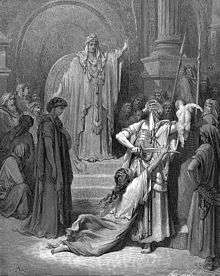
Historical evidence of King Solomon other than the biblical accounts has been so minimal that some scholars have understood the period of his reign as a 'Dark Age' (Muhly 1998). The first-century Romano-Jewish scholar Josephus in Against Apion, citing Tyrian court records and Menander, gives a specific year during which King Hiram I of Tyre sent materials to Solomon for the construction of the Temple.[52] However, no material evidence indisputably of Solomon's reign has been found. Yigael Yadin's excavations at Hazor, Megiddo, Beit Shean and Gezer uncovered structures that he and others have argued date from Solomon's reign,[53] but others, such as Israel Finkelstein and Neil Silberman, argue that they should be dated to the Omride period, more than a century after Solomon.[30]
According to Finkelstein and Silberman, authors of The Bible Unearthed: Archaeology's New Vision of Ancient Israel and the Origin of Its Sacred Texts,[54] at the time of the kingdoms of David and Solomon, Jerusalem was populated by only a few hundred residents or less, which is insufficient for an empire stretching from the Euphrates to Eilath. According to The Bible Unearthed, archaeological evidence suggests that the kingdom of Israel at the time of Solomon was little more than a small city state, and so it is implausible that Solomon received tribute as large as 666 talents of gold per year. Although both Finkelstein and Silberman accept that David and Solomon were real inhabitants of Judah about the 10th century BCE,[47] they claim that the earliest independent reference to the Kingdom of Israel is about 890 BCE, and for Judah about 750 BCE. They suggest that because of religious prejudice, the authors of the Bible suppressed the achievements of the Omrides (whom the Hebrew Bible describes as being polytheist), and instead pushed them back to a supposed golden age of Judaism and monotheists, and devotees of Yahweh. Some Biblical minimalists like Thomas L. Thompson go further, arguing that Jerusalem became a city and capable of being a state capital only in the mid-7th century.[55] Likewise, Finkelstein and others consider the claimed size of Solomon's temple implausible.
Arguments in favour of biblical description
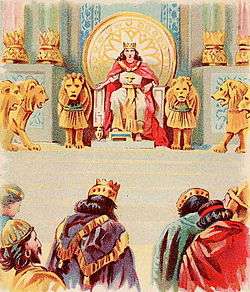
These views are criticized by William G. Dever[56] and André Lemaire,[57] among others. Lemaire states in Ancient Israel: From Abraham to the Roman Destruction of the Temple[57] that the principal points of the biblical tradition of Solomon are generally trustworthy, although elsewhere he writes that he could find no substantiating archaeological evidence that supports the Queen of Sheba's visit to king Solomon, saying that the earliest records of trans-Arabian caravan voyages from Tayma and Sheba unto the Middle-Euphrates etc. occurred in the mid-8th century BCE,[58] placing a possible visit from the Queen of Sheba to Jerusalem around this time—some 250 years later than the timeframe traditionally given for king Solomon's reign.[59] Kenneth Kitchen argues that Solomon ruled over a comparatively wealthy "mini-empire", rather than a small city-state, and considers 666 gold talents a modest amount of money. Kitchen calculates that over 30 years, such a kingdom might have accumulated up to 500 tons of gold, which is small compared to other examples, such as the 1,180 tons of gold that Alexander the Great took from Susa.[60] Similarly, Kitchen[61] and others consider the temple of Solomon a reasonable and typically sized structure for the region at the time. Dever states "that we now have direct Bronze and Iron Age parallels for every feature of the 'Solomonic temple' as described in the Hebrew Bible".[62]
Middle way
Some scholars have charted a middle path between minimalist scholars like Finkelstein, Silberman, and Philip Davies[63] (who believes that "Solomon is a totally invented character")[64] and maximalist scholars like Dever, Lemaire and Kitchen. For instance, the archaeologist Avraham Faust has argued that biblical depictions of Solomon date to later periods and do overstate his wealth, buildings, and kingdom, but that Solomon did have an acropolis and ruled over a polity larger than Jerusalem.[65] In particular, his archaeological research in regions near Jerusalem, like Sharon, finds commerce too great not to be supported by a polity and such regions probably were ruled loosely by Jerusalem.[66][67] Scholars like Lester Grabbe also believe that there must have been a ruler in Jerusalem during this period and that he likely built a temple, although the town was quite small.[68]
Archaeology
General observations
The archaeological remains that are considered to date from the time of Solomon are notable for the fact that Canaanite material culture appears to have continued unabated; there is a distinct lack of magnificent empire, or cultural development—indeed comparing pottery from areas traditionally assigned to Israel with that of the Philistines points to the latter having been significantly more sophisticated. However, there is a lack of physical evidence of its existence, despite some archaeological work in the area.[30] This is not unexpected because the area was devastated by the Babylonians, then rebuilt and destroyed several times.[61]
Temple Mount in Jerusalem
Little archaeological excavation has been done around the area known as the Temple Mount, in what is thought to be the foundation of Solomon's Temple, because attempts to do so are met with protests by the Muslim authorities.[69][70]
Precious metals from Tarshish
The biblical passages that understand Tarshish as a source of King Solomon's great wealth in metals—especially silver, but also gold, tin and iron (Ezekiel 27)—were linked to archaeological evidence from silver-hoards found in Phoenicia in 2013. The metals from Tarshish were reportedly obtained by Solomon in partnership with King Hiram of Phoenician Tyre (Isaiah 23), and the fleets of Tarshish-ships that sailed in their service, and the silver-hoards provide the first recognized material evidence that agrees with the ancient texts concerning Solomon's kingdom and his wealth (see 'wealth' below).
Possible evidence for the described wealth of Solomon and his kingdom was discovered in ancient silver-hoards, which were found in Israel and Phoenicia and recognized for their importance in 2003. The evidence from the hoards shows that the Levant was a center of wealth in precious metals during the reign of Solomon and Hiram, and matches the texts that say the trade extended from Asia to the Atlantic Ocean.[71]
Biblical criticism: Solomon's religiosity
From a critical point of view, Solomon's building of a temple for Yahweh should not be considered an act of particular devotion to Yahweh because Solomon is also described as building places of worship for a number of other deities.[40] Some scholars and historians argue that Solomon's apparent initial devotion to Yahweh, described in passages such as his dedication prayer (1 Kings 8:14–66), were written much later, after Jerusalem had become the religious centre of the kingdom, replacing locations such as Shiloh and Bethel. Earlier historians maintain that there is evidence that these passages in Kings are derived from official court records at the time of Solomon and from other writings of that time that were incorporated into the canonical books of Kings.[72][73][74] More recent scholars believe that passages such as these in the Books of Kings were not written by the same authors who wrote the rest of the text, instead probably by the Deuteronomist.[62]
Religious views
Judaism
King Solomon sinned by acquiring many foreign wives and horses because he thought he knew the reason for the biblical prohibition and thought it did not apply to him. When King Solomon married the daughter of the Egyptian Pharaoh, a sandbank formed which eventually formed the "great nation of Rome"—the nation that destroyed the Second Temple (Herod's Temple). Solomon gradually lost more and more prestige until he became like a commoner. Some say he regained his status while others say he did not. In the end however, he is regarded as a righteous king and is especially praised for his diligence in building the Temple.[75] King Josiah was also said to have had the Ark of the Covenant, Aaron's rod, vial of manna and the anointing oil placed within a hidden chamber which had been built by King Solomon[76][77]
The Seder Olam Rabba holds that Solomon's reign was not in 1000 BCE, but rather in the 9th century BCE, during which time he built the First Temple in 832 BCE.[78] However, the 1906 Jewish Encyclopedia gives the more common date of "971 to 931 BCE".[11]
Christianity
Christianity has traditionally accepted the historical existence of Solomon, though some modern Christian scholars have also questioned at least his authorship of those biblical texts ascribed to him. Such disputes tend to divide Christians into traditionalist and modernist camps.
Of the two genealogies of Jesus given in the Gospels, Matthew mentions Solomon, but Luke does not. Some commentators see this as an issue that can be reconciled while others disagree. For instance, it has been suggested that Matthew is using Joseph's genealogy and Luke is using Mary's, but Darrell Bock states that this would be unprecedented, "especially when no other single woman appears in the line". Other suggestions include the use by one of the royal and the other of the natural line, one using the legal line and the other the physical line, or that Joseph was adopted.[79]
Jesus makes reference to Solomon, using him for comparison purposes in his admonition against worrying about your life. This account is recorded in Matthew 6:29 and the parallel passage in Luke 12:27
In the Eastern Orthodox Church, Solomon is commemorated as a saint, with the title of "Righteous Prophet and King". His feast day is celebrated on the Sunday of the Holy Forefathers (two Sundays before the Great Feast of the Nativity of the Lord).
The staunchly Catholic King Philip II of Spain sought to model himself after King Solomon. Statues of King David and Solomon stand on either side of the entrance to the basilica of El Escorial, Philip's palace, and Solomon is also depicted in a great fresco at the center of El Escorial's library. Philip identified the warrior-king David with his own father Charles V, and himself sought to emulate the thoughtful and logical character which he perceived in Solomon. Moreover, the structure of the Escorial was inspired by that of Solomon's Temple.[80][81]
Islam
In Islamic tradition, Solomon is venerated as a prophet and a messenger of God, as well as a divinely appointed monarch, who ruled over the Kingdom of Israel.[82] Solomon inherited his position from his father as the prophetic King of the Israelites. Unlike in the Bible where Solomon was granted an incomparable realm because God was impressed by his wish to have wisdom,[83] the Quran states that Solomon prayed earnestly to God to grant him a kingdom which would be greater than any realm before or after him.[84] As in Judaism, Islam recognizes Solomon as the son of King David, who is also considered a prophet and a king but refuses to accuse Solomon of idolatry, claiming instead that an enslaved jinn escaped his captivity and took over his kingdom and posed as Solomon, while others thought indeed that he became a ruthless king.[85]
And they followed what the devils taught during the reign of Solomon. It was not Solomon who disbelieved, but it was the devils who disbelieved. They taught the people witchcraft and what was revealed in Babil (Arabic: بَـابِـل, Babylon) to the two angels Harut and Marut. They did not teach anybody until they had said "We are a test, so do not lose faith." But they learned from them the means to cause separation between man and his wife. But they cannot harm anyone except with God's permission. And they learned what would harm them and not benefit them. Yet they knew that whoever deals in it will have no share in the Hereafter. Miserable is what they sold their souls for, if they only knew.[82]
The Quran[86][87][88] ascribes to Solomon a great level of wisdom, knowledge and power. He knew the Mantiq al-tayr (Arabic: مـنـطـق الـطـيـر, language of the birds).[87][89] Solomon was also known in Islam to have other supernatural abilities bestowed upon him by Allah, after a special request by Solomon himself, such as controlling the wind, ruling over the jinn, enslaving demons, and hearing the communication of ants:
"And to Solomon (We made) the wind (obedient): its early morning (stride) was a month's (journey), and its evening (stride) was a month's (journey); and We made a font of molten brass to flow for him; and there were Jinns that worked in front of him, by the leave of his Lord, and if any of them turned aside from Our command, We made him taste of the Penalty of the Blazing Fire."[90] (34: 12) and "At length, when they came to a (lowly) valley of ants, one of the ants said: 'O ye ants, get into your habitations, lest Solomon and his hosts crush you (under foot) without knowing it.'—So he smiled, amused at her speech; and he said: 'O my Rabb (Arabic: رَبّ, Lord)! So order me that I may be grateful for Thy favors, which Thou hast bestowed on me and on my parents, and that I may work the righteousness that will please Thee: and admit me, by Thy Grace, to the ranks of Thy righteous Servants.'" (27: 18–19)
The Quran mentions Solomon 17 times.
Bahá'í
In the Bahá'í Faith, Solomon is regarded as one of the lesser prophets along with David, Isaiah, Jeremiah, Ezekiel, along with others.[91] Baha'is see Solomon as a prophet who was sent by God to address the issues of his time.[92] Baha'ullah wrote about Solomon in the Hidden Words.[93] He also mentions Solomon in the Tablet of Wisdom, where he is depicted as a contemporary of Pythagoras.[94]
Legends
One Thousand and One Nights
A well-known story in the collection One Thousand and One Nights describes a genie who had displeased King Solomon and was punished by being locked in a bottle and thrown into the sea. Since the bottle was sealed with Solomon's seal, the genie was helpless to free himself, until he was freed many centuries later by a fisherman who discovered the bottle.[95] In other stories from the One Thousand and One Nights, protagonists who had to leave their homeland and travel to the unknown places of the world saw signs which proved that Solomon had already been there. Sometimes, protagonists discovered words of Solomon that were intended to help those who were lost and had unluckily reached those forbidden and deserted places.
Angels and magic
According to the Rabbinical literature, on account of his modest request for wisdom only, Solomon was rewarded with riches and an unprecedented glorious realm, which extended over the upper world inhabited by the angels and over the whole of the terrestrial globe with all its inhabitants, including all the beasts, fowl, and reptiles, as well as the demons and spirits. His control over the demons, spirits, and animals augmented his splendor, the demons bringing him precious stones, besides water from distant countries to irrigate his exotic plants. The beasts and fowl of their own accord entered the kitchen of Solomon's palace, so that they might be used as food for him, and extravagant meals for him were prepared daily by each of his 700 wives and 300 concubines, with the thought that perhaps the king would feast that day in her house.
Seal of Solomon
A magic ring called the "Seal of Solomon" was supposedly given to Solomon and gave him power over demons or Jinn. The magical symbol said to have been on the Seal of Solomon which made it efficacious is often considered to be the Star of David though this emblem (also known as the Shield of David) is known to have been associated with Judaism only as recently as the 11th century CE while the five pointed star (pentagram) can be found on jars and other artifacts from Jerusalem dating back to at least the 2nd and 4th centuries BCE and is more likely to have been the emblem found on the ring purportedly used by King Solomon to control the Jinn or demons. Asmodeus, king of demons, was one day, according to the classical Rabbis, captured by Benaiah using the ring, and was forced to remain in Solomon's service. In one tale, Asmodeus brought a man with two heads from under the earth to show Solomon; the man, unable to return, married a woman from Jerusalem and had seven sons, six of whom resembled the mother, while one resembled the father in having two heads. After their father's death, the son with two heads claimed two shares of the inheritance, arguing that he was two men; Solomon decided that the son with two heads was only one man. The Seal of Solomon, in some legends known as the Ring of Aandaleeb, was a highly sought after symbol of power. In several legends, different groups or individuals attempted to steal it or attain it in some manner.
Solomon and Asmodeus
One legend concerning Asmodeus (see: The Story of King Solomon and Ashmedai) goes on to state that Solomon one day asked Asmodeus what could make demons powerful over man, and Asmodeus asked to be freed and given the ring so that he could demonstrate; Solomon agreed but Asmodeus threw the ring into the sea and it was swallowed by a fish. Asmodeus then swallowed the king, stood up fully with one wing touching heaven and the other earth, and spat out Solomon to a distance of 400 miles. The Rabbis claim this was a divine punishment for Solomon's having failed to follow three divine commands, and Solomon was forced to wander from city to city, until he eventually arrived in an Ammonite city where he was forced to work in the king's kitchens. Solomon gained a chance to prepare a meal for the Ammonite king, which the king found so impressive that the previous cook was sacked and Solomon put in his place; the king's daughter, Naamah, subsequently fell in love with Solomon, but the family (thinking Solomon a commoner) disapproved, so the king decided to kill them both by sending them into the desert. Solomon and the king's daughter wandered the desert until they reached a coastal city, where they bought a fish to eat, which just happened to be the one which had swallowed the magic ring. Solomon was then able to regain his throne and expel Asmodeus. The element of a ring thrown into the sea and found back in a fish's belly also appeared in Herodotus' account of Polycrates, the tyrant of Samos (c. 538–522 BCE).
In another familiar version of the legend of the Seal of Solomon, Asmodeus disguises himself. In some myths, he's disguised as King Solomon himself, while in more frequently heard versions he's disguised as a falcon, calling himself Gavyn (Gavinn or Gavin), one of King Solomon's trusted friends. The concealed Asmodeus tells travelers who have ventured up to King Solomon's grand lofty palace that the Seal of Solomon was thrown into the sea. He then convinces them to plunge in and attempt to retrieve it, for if they do they would take the throne as king.
Artifacts
Other magical items attributed to Solomon are his key and his Table. The latter was said to be held in Toledo, Spain during Visigoth rule and was part of the loot taken by Tarik ibn Ziyad during the Umayyad Conquest of Iberia, according to Ibn Abd-el-Hakem's History of the Conquest of Spain. The former appears in the title of the Lesser Key of Solomon, a grimoire whose framing story is Solomon capturing demons using his ring, and forcing them to explain themselves to him. In The Book of Deadly Names, purportedly translated from Arabic manuscripts found hidden in a building in Spain, the "King of the Jinn" Fiqitush brings 72 Jinn before King Solomon to confess their corruptions and places of residence. Fiqitush tells King Solomon the recipes for curing such corruptions as each evil Jinn confesses.
Angels
Angels also helped Solomon in building the Temple; though not by choice. The edifice was, according to rabbinical legend, miraculously constructed throughout, the large heavy stones rising and settling in their respective places of themselves. The general opinion of the Rabbis is that Solomon hewed the stones by means of a shamir, a mythical worm whose mere touch cleft rocks. According to Midrash Tehillim, the shamir was brought from paradise by Solomon's eagle; but most of the rabbis state that Solomon was informed of the worm's haunts by Asmodeus. The shamir had been entrusted by the prince of the sea to the mountain rooster alone, and the rooster had sworn to guard it well, but Solomon's men found the bird's nest, and covered it with glass. When the bird returned, it used the shamir to break the glass, whereupon the men scared the bird, causing it to drop the worm, which the men could then bring to Solomon.
In the Kabbalah
Early adherents of the Kabbalah portray Solomon as having sailed through the air on a throne of light placed on an eagle, which brought him near the heavenly gates as well as to the dark mountains behind which the fallen angels Uzza and Azzazel were chained; the eagle would rest on the chains, and Solomon, using the magic ring, would compel the two angels to reveal every mystery he desired to know.
The palace without entrance
According to one legend, while traveling magically, Solomon noticed a magnificent palace to which there appeared to be no entrance. He ordered the demons to climb to the roof and see if they could discover any living being within the building but they found only an eagle, which said that it was 700 years old, but that it had never seen an entrance. An elder brother of the eagle, 900 years old, was then found, but it also did not know the entrance. The eldest brother of these two birds, which was 1,300 years old, then declared it had been informed by its father that the door was on the west side, but that it had become hidden by sand drifted by the wind. Having discovered the entrance, Solomon found an idol inside that had in its mouth a silver tablet saying in Greek (a language not thought by modern scholars to have existed 1000 years before the time of Solomon) that the statue was of Shaddad, the son of 'Ad, and that it had reigned over a million cities, rode on a million horses, had under it a million vassals and slew a million warriors, yet it could not resist the angel of death.[11]
Throne
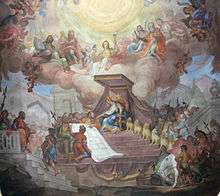
Solomon's throne is described at length in Targum Sheni, which is compiled from three different sources, and in two later Midrash. According to these, there were on the steps of the throne twelve golden lions, each facing a golden eagle. There were six steps to the throne, on which animals, all of gold, were arranged in the following order: on the first step a lion opposite an ox; on the second, a wolf opposite a sheep; on the third, a tiger opposite a camel; on the fourth, an eagle opposite a peacock, on the fifth, a cat opposite a cock; on the sixth, a sparrow-hawk opposite a dove. On the top of the throne was a dove holding a sparrow-hawk in its claws, symbolizing the dominion of Israel over the Gentiles. The first midrash claims that six steps were constructed because Solomon foresaw that six kings would sit on the throne, namely, Solomon, Rehoboam, Hezekiah, Manasseh, Amon, and Josiah. There was also on the top of the throne a golden candelabrum, on the seven branches of the one side of which were engraved the names of the seven patriarchs Adam, Noah, Shem, Abraham, Isaac, Jacob, and Job, and on the seven of the other the names of Levi, Kohath, Amram, Moses, Aaron, Eldad, Medad, and, in addition, Hur (another version has Haggai). Above the candelabrum was a golden jar filled with olive oil and beneath it a golden basin which supplied the jar with oil and on which the names of Nadab, Abihu, and Eli and his two sons were engraved. Over the throne, twenty-four vines were fixed to cast a shadow on the king's head.[11]
By a mechanical contrivance the throne followed Solomon wherever he wished to go. Supposedly, due to another mechanical trick, when the king reached the first step, the ox stretched forth its leg, on which Solomon leaned, a similar action taking place in the case of the animals on each of the six steps. From the sixth step the eagles raised the king and placed him in his seat, near which a golden serpent lay coiled. When the king was seated the large eagle placed the crown on his head, the serpent uncoiled itself, and the lions and eagles moved upward to form a shade over him. The dove then descended, took the scroll of the Law from the Ark, and placed it on Solomon's knees. When the king sat, surrounded by the Sanhedrin, to judge the people, the wheels began to turn, and the beasts and fowls began to utter their respective cries, which frightened those who had intended to bear false testimony. Moreover, while Solomon was ascending the throne, the lions scattered all kinds of fragrant spices. After Solomon's death, Pharaoh Shishak, when taking away the treasures of the Temple (I Kings xiv. 26), carried off the throne, which remained in Egypt until Sennacherib conquered that country. After Sennacherib's fall Hezekiah gained possession of it, but when Josiah was slain by Pharaoh Necho, the latter took it away. However, according to rabbinical accounts, Necho did not know how the mechanism worked and so accidentally struck himself with one of the lions causing him to become lame; Nebuchadnezzar, into whose possession the throne subsequently came, shared a similar fate. The throne then passed to the Persians, whose king Darius was the first to sit successfully on Solomon's throne after his death; subsequently the throne came into the possession of the Greeks and Ahasuerus.[11]
Freemasonry
Masonic rituals refer to King Solomon and the building of his Temple.[96] Masonic Temples, where a Masonic Lodge meets, are an allegorical reference to King Solomon's Temple.[97]
In literature, art, and music
Literature
- In H. Rider Haggard's King Solomon's Mines (1885) the protagonists discover multiple settings said to belong to, or having been built at the request of King Solomon, such as 'Solomon's Great Road' and the mines themselves. Also, the two mountains which form the entrance to Kukuana Land (where the mines are located in the novel) are referred to as 'Sheba's Breasts' which could well be an allusion to the Queen of Sheba, with whom King Solomon had a relationship; or alternatively Solomon's mother, who was named Bathsheba. When in the mines the characters also contemplate what must have occurred to prevent King Solomon from ever returning to retrieve the massive amounts of diamonds, gold and ivory tusks that were found buried in his great 'Treasure Chamber'.
- In The Divine Comedy the spirit of Solomon appears to Dante Alighieri in the Heaven of the Sun with other exemplars of inspired wisdom.
- In Friedrich Dürrenmatt's Die Physiker, the physicist Möbius claims that Solomon appears to him and dictates the "theory of all possible inventions" (based on Unified Field Theory).
- Solomon appears in Kipling's Just So Stories.
- In Neal Stephenson's three-volume The Baroque Cycle, 17th-century alchemists like Isaac Newton believe that Solomon created a kind of "heavier" gold with mystical properties and that it was cached in the Solomon Islands where it was accidentally discovered by the crew of a wayward Spanish galleon. In the third volume of The Baroque Cycle, The System of the World, a mysterious member of the entourage of Czar Peter I of Russia, named "Solomon Kohan" appears in early 18th-century London. The czar, traveling incognito to purchase English-made ships for his navy, explains that he added him to his court after the Sack of Azov, where Kohan had been a guest of the Pasha. Solomon Kohan is later revealed as one of the extremely long-lived "Wise," such as Enoch Root, and compares a courtyard full of inventors' workstations to "an operation I used to have in Jerusalem a long time ago", denominating either facility as "a temple". Stephenson's sequel to Reamde, 2019's Fall; or, Dodge in Hell was also a surprise sequel to the Baroque Cycle novels and Cryptonomicon. In the mid- to late-21st century span of Fall, Solomon Kohan has joined the faculty of Princeton University, going by Solly Pesador, and is described by a student as "one of those guys who had been around forever and played roles in tech companies going at least as far back as Hewlett-Packard" and as an "old-school tech geek turned neuro-hacker."
- In Bartimaeus: The Ring of Solomon, both King Solomon and the Queen of Sheba are featured prominently.
- Solomon, King of Urushalim, is a significant character in The Shadow Prince,[98] the first novel of Philip Armstrong's epic historical fantasy, The Chronicles of Tupiluliuma. His Ring is an Atalantaën Relic, by which is he able to command daemons. He uses it to summon a daemon army, thereafter called the Cohort of Free Daemons, to oppose the forces of the Chaos God, Sutekh, thus allowing the young Hittite musician, Lisarwa, to repair the Veil that separates the physical world from the dangerous wild energies of the Netherworld, using another of the relics, the Harp of Daud, once owned by his father (King David). Solomon's son, Rehoboam also appears in a minor capacity.
- In the Japanese manga series Magi: The Labyrinth of Magic, Solomon was a powerful magician who united all of the world under his peaceful rule. However, when this world was destroyed by a calamity, he created the world Magi is set in and saved mankind by sending them there. A special power originated from him, the "Wisdom of Solomon", allows the main character Aladdin to talk directly with the soul of a person, alive or dead.
- In Makai Ouji: Devils and Realist, Solomon is a friend of Lucifer and is the "Elector"—the one who can choose the interim ruler over Hell as its emperor rests to regain his strength and had powers over demons known as his seventy-two pillars. He's also known as the one who can control Hell or Heaven with the power of his ring.
- Chapter 14 of The Adventures of Huckleberry Finn ends with Huck and Jim debating over how wise Solomon really was.
- In Francis Bacon's Essay 'Of Revenge', Solomon is paraphrased: "And Solomon, I am sure, saith, It is the glory of a man, to pass by an offence."
- In DC Comics, Solomon is one of the Immortal Elders of the hero Captain Marvel.
- In a subject called in art the Idolatry of Solomon, the foreign wives are depicted as leading Solomon away from Yahweh toward idolatry because they worshiped gods other than Yahweh (1 Kings 11:1–3). This forms part of the Power of Women topos in the Middle Ages and Renaissance, showing the dangers women posed to even the most virtuous men.[99]
- Naamah, a princess of Ammon, (part of present day Jordan) who arrives in Jerusalem at age fourteen to marry King Solomon and tells of their life together, is the narrator of Aryeh Lev Stollman's novel published by Aryeh Nir/Modan (Tel Aviv) in Hebrew translation under the title Divrei Y'mai Naamah (דברי ימי נעמה).
Film
- Solomon and Sheba (1959)—Epic film directed by King Vidor, starring Yul Brynner and Gina Lollobrigida
- Solomon & Sheba (1995)—Showtime film directed by Robert M. Young starring Halle Berry and Jimmy Smits
- Solomon (1997, TNT)—directed by Roger Young, starring Ben Cross
- Brooklyn Babylon (2001)— a modern retelling of the story of Solomon and the Queen of Sheba, set during the Crown Heights riot
- The Kingdom of Solomon (2009)—Iranian production directed by Shahriar Bahrani
- The Song (2014)—a modern retelling directed by Richard Ramsey, starring Alan Powell, Ali Faulkner, and Caitlin Nicol-Thomas[100][101]
Music
- Giacomo Carissimi, The Judgment of Solomon for three chorus, two violins and organ
- Marc-Antoine Charpentier, Judicium Salomnis, H 422, Oratorio for soloists, chorus, orchestra, and continuo 1702
- Sébastien de Brossard, Solomon's fall, cantata
- Handel composed an oratorio entitled Solomon in 1748. The story follows the basic biblical plot.[102]
- Ernest Bloch composed a Hebraic Rhapsody for cello and orchestra entitled Schelomo, based on King Solomon.
- Kate Bush wrote a song called "Song of Solomon" in 1993 for her album The Red Shues.
- Toivo Tulev composed a piece for choir, soloists and chamber orchestra entitled Songs in 2005. The text is taken directly from the Song of Songs in its English, Spanish and Latin translations.
- Derrick Harriott has a rocksteady song titled Solomon (later covered by Junior Murvin), in which he warns a woman that he is wiser than Solomon in the ways of women.
- Jamaican dancehall rapper Sean Paul mentions King Solomon in his 2005 hit song We Be Burnin. Specifically Sean Paul references the legend that marijuana was found on the grave of King Solomon.
- The New Pornographers included a song entitled "One Kind of Solomon" on their 2019 album In the Morse Code of Brake Lights.
- Cassandra Wilson performs the self-penned ‘Solomon Sang’ on her 1995 Blue Note album, New Moon Daughter.
See also
- Goetia
- Heichal Shlomo
- Kings of Israel and Judah
- Solomon and Marcolf
- Solomon in Islam
- Solomon's Pools
- Solomonic column
- The Judgement of Solomon (Giorgione)
Notes
- Hebrew: שְׁלֹמֹה, Modern: Šlōmō, Tiberian: Šelōmō ISO 259-3 Šlomo; Syriac: ܫܠܝܡܘܢ Šlemūn; Arabic: سُليمان Sulaymān, also colloquially: Silimān or Slemān; Greek: Σολομών Solomōn; Latin: Salomon)
- Recent History Channel promotional production about Indiana Jones's positive impact on archaeology (released Mid-May 2008, the week before the 22 May 2008 US release of Indiana Jones and the Kingdom of the Crystal Skull); History Channel producers were shown interviewing the guardian priest, and expert discussions about the Ark were part of the fare.
References
- "In Our Time With Melvyn Bragg: King Solomon". UK: BBC Radio 4. 7 June 2012. Retrieved 2012-06-10.
- Holy Bible. 1 Kings 11:1–3.CS1 maint: location (link)
- Book of Kings: 1 Kings 1–11; Book of Chronicles: 1 Chronicles 28–29, 2 Chronicles 1–9
- Barton, George A. (1906). "Temple of Solomon". Jewish Encyclopedia. pp. 98–101. Retrieved 2018-10-24.
- Stefon, Matt. "Solomon king of Israel". britannica.com. Britannica.
- Rashi, to Megillah, 14a
- 1 Kings 5:3; 8:20
- Matthew 12:42; Luke 11:31
- Matthew 6:28–29; Luke 12:27
- "Archaeology, Culture, and other Religions". FMC terra santa. Retrieved 2013-06-21.
-

- E. Clarity, 2012, p. 305.
- Thiele 1983, p. 78.
- 1 Chronicles 14:4
- 1 Chronicles 3:5
- 1 Chronicles 3:1–4
- Vance, Jennifer (2015). Solomon. New York: Simon and Schuster. ISBN 9781681461182.
- Golden childhood. The Little People's Own Pleasure—Book of Delight and Instruction. London: Ward, Lock, and Co. 1878. p. 116.
- Farrel, Pam; Jones, Jean (2017). Discovering Hope in the Psalms: A Creative Bible Study Experience. Eugene: Harvest House Publishers. p. 70. ISBN 9780736969970.
- "1 Kings 1 (ESV)". BibleGateway.com. Retrieved 2010-03-03.
- Lumby, J. R., Cambridge Bible for Schools and Colleges on 1 Kings 1, accessed 24 September 2017
- 1 Kings 4:1–19
- Wiersbe, Warren (2003). The Bible Exposition Commentary, Volume 1. Eastbourne: Cook Communications. pp. 496. ISBN 9780781435314.
- 1 Kings 3:3–15
- 1 Kings 3:16–28
- Coogan 2009, p. 375.
- 1 Kings 10:17 and 2 Chronicles 9:20: "House" in the King James Version and Revised Standard Version, "Hall" in the Jerusalem Bible and Good News Translation
- 1 Kings 7:1-8
- 1 Kings 9:15
- Finkelstein & Silberman 2001, pp. 186–195
- 1 Kings 11:3; not in the 2 Chronicles account
- See also 1 Kings 3:1
- 1 Kings 11:2–3: NKJV
- "1 Kings 12—2 Kings 25:", Introduction to the Hebrew Bible, Fortress Press, pp. 281–304, ISBN 978-1-5064-4605-9, retrieved 2019-12-19
- 1 Kings 11:1: The Message
- 1 Kings 11:5–9: NKJV
- "Loving too well: The negative portrayal of Solomon and the composition of the Kings history". Retrieved on Jan. 17, 2007
- Stuart Munro-Hay, The Quest for the Ark of the Covenant: The True History of the Tablets of Moses.
- Donald N. Levine, Wax and Gold: Tradition and Innovation in Ethiopia Culture (Chicago: University Press, 1972).
-

- "NIV 1 Kings 11 (Solomon's Wives)". Bible Gateway. Retrieved 2013-06-21.
- "The Kingdom of Israel". Jewish Virtual Library. Retrieved 2010-03-03.
- Gottlieb, Isaac (2010). "Mashal Le-Melekh: The Search for Solomon". Hebrew Studies. 51 – via Gale Literature Resource Center.
- Dahood, Mitchell (1968). Psalms II, 51-100: Introduction, Translation, and Notes. New York: Doubleday. pp. 179–180. ISBN 0385037597.
- The Anchor Bible. New York: Doubleday. 1964. p. 47.
- "Solomon, Testament of". Jewish Encyclopedia. Retrieved 2010-03-03.
- Finkelstein & Silberman 2006, p. 20.
- Lipschits, Oded (2014). "The history of Israel in the biblical period". In Berlin, Adele; Brettler, Marc Zvi (eds.). The Jewish Study Bible (2nd ed.). Oxford University Press. ISBN 978-0-19-997846-5.
- Finkelstein, Israel; Silberman, Neil Asher (2001). The Bible Unearthed: Archaeology's New Vision of Ancient Israel and the Origin of its Stories. New York: Simon & Schuster. ISBN 978-0-684-86912-4.
- Kuhrt, Amélie (1995). The Ancient Near East, c. 3000-330 BC, Band 1. New York: Routledge. p. 438. ISBN 978-0-41516-762-8.
- Wright, Jacob L. (July 2014). "David, King of Judah (not Israel)". The Bible and Interpretation.
- Against Apion i:17, 18.
- Dever 2001.
- Finkelstein & Silberman 2001, p. 133.
- Thompson, Thomas L., 1999, The Bible in History: How Writers Create a Past, Jonathan Cape, London, ISBN 978-0-224-03977-2 p. 207
- Dever 2001, p. 160.
- Shanks, Hershel, Ancient Israel: From Abraham to the Roman Destruction of the Temple, p. 113
- See: Lemaire, South Arabia. In André Lemaire's own words: "The first mention of Sheba in Neo-Assyrian texts is to be dated mid-8th century BCE with the story of a caravan of 200 camels coming from Tayma and Sheba to Hindanu (Middle-Euphrates) (Cavigneaux–Ismaïl 1990: 339–357; Frame 1995: 300; Younger 2003: 279–282; Holladay 2006: 319–321)."
- André Lemaire, The Queen of Sheba and the Trade Between South Arabia and Judah, pub. in Bayn ʻEver LaʻArav: Contacts between Arabic Literature and Jewish Literature in the Middle Ages and Modern Times, volume 6; A Collection of Studies Dedicated to Prof. Yosef Tobi on the Occasion of his Retirement, ed. Ali A. Hussein and Ayelet Oettinger (Haifa: University of Haifa Press, 2013), xi–xxxiv
- Kitchen 2003, p. 135.
- Kitchen 2003, p. 123
- Dever 2001, p. 145
- Davies, Philip R. 1992. In Search of 'Ancient Israel': A Study in Biblical Origins. London: Bloomsbury Publishing, T and T Clark.
- "David and Solomon". www.bibleodyssey.org. Retrieved 2017-11-09.
- Faust, Avraham. 2012. The Archaeology of Israelite Society in Iron Age II. Translated by Ruth Ludlum. Winona Lake, IN: Eisenbrauns.
- Faust, Avraham. 2007. "The Sharon and the Yarkon Basin in the Tenth Century BCE: Ecology, Settlement Patterns and Political Involvement". Israel Exploration Journal:65–82.
- Faust, Avraham. 2017. "Jebus, the City of David, and Jerusalem: Jerusalem from the Iron I to the Neo-Babylonian Period [in Hebrew]." In Jerusalem: From its Beginning to the Ottoman Conquest, edited by Avraham Faust, J. Schwartz and E. Baruch, 35–72. Ramat Gan: Ingeborg Renner Center for Jerusalem Studies.
- Grabbe, Lester L. 2016. 1 & 2 Kings: An Introduction and Study Guide: History and Story in Ancient Israel: Bloomsbury Publishing.
- "Temple Mount: Excavation Controversy". Sacred destinations. Archived from the original on 2009-06-21. Retrieved 2010-03-03.
- Jacqueline Schaalje. "Special: The Temple Mount in Jerusalem". Jewish Magazine. Archived from the original on 2009-10-06. Retrieved 2018-04-07.CS1 maint: BOT: original-url status unknown (link)
- Thompson, Christine; Skaggs, Sheldon (2013). "King Solomon's Silver? Southern Phoenician Hacksilber Hoards and the Location of Tarshish". Internet Archaeology (35). doi:10.11141/ia.35.6.
- Harrison, RK (1969), Introduction to the Old Testament, Grand Rapids: Eerdmans, pp. 722–724
- Archer, GL (1964), A Survey of Old Testament Introduction, Chicago: Moody Press, pp. 276–277
- Thiele 1983, p. 193–204.
- "tractate Sanhendrin", Talmud Bavli, p. 21b
- Tosefta (Sotah 13:1); cf. Babylonian Talmud (Kereithot 5b)
- "A Buried Treasure: The Entombment of the Ark". www.chabad.org.
- Seder Olam Rabba, Jerusalem 1971 (Hebrew)
- Bock, Darell (1996). Luke. The NIV Application Commentary. Zondervan. p. 124. ISBN 978-0-310-49330-3.
- Taylor, René, Arquitectura y Magia. Consideraciones sobre la Idea de El Escorial [Architecture and magic. Considerations on the idea of the Escorial] (in Spanish), Madrid: Siruela, enhanced from monograph in Rudolph Wittkower's 1968 festschrift.
- Wittkower, Rudolf; Jaffe, Irma, "Hermetism and the Mystical Architecture of the Society of Jesus", Baroque Art: The Jesuit Contribution
- Quran %3Averse%3D102 2 :102
- 2 Chronicles 1:7–12
- Quran 38:35
- Robert Lebling Legends of the Fire Spirits: Jinn and Genies from Arabia to Zanzibar I.B.Tauris 2010 ISBN 978-0-857-73063-3
- "Qur'an, 21: 79–82".
- "Qur'an, 27: 15–19".
- Quran %3Averse%3D12 34 :12
- "Qur'an, 35: 35–38".
- "Quran Surah Saba ( Verse 12 )". Archived from the original on 2018-01-27. Retrieved 2018-01-26.
- Smith, Peter (2008), An Introduction to the Baha'i Faith, p. 108
- Steier, E Joseph, III; Timmering, Dianne H (2008), My God! Our God?, p. 176
- Ryba, Thomas; Bond, George D; Tull, Herman (2004), The Comity and Grace of Method: Essays in Honor of Edmund F. Perry, p. 399
- Garlington, William (2005), The Baha'i Faith in America, p. 160
- "The Story of the Fisherman", Stories from the Thousand and One Nights, The Harvard Classics, 1909–14
- "Index of /". lodgechelmsford.com. Retrieved 2014-08-29.
- "Freemasons NSW ACT—Home". masons.org.au. Retrieved 2014-08-29.
- Armstrong, Philip (2016-07-17). The Shadow Prince. ISBN 978-1533673503.
- H Diane Russell (ed), Eva/Ave; Women in Renaissance and Baroque Prints, pp. 162–164, National Gallery of Art, Washington, 1990, ISBN 1558610391
- "The Song Movie—Inspired by the Song of Solomon". The Song Movie—Inspired by the Song of Solomon.
- "'The Song' is a modern story of love, faith". www.catholicsentinel.org. Catholic Sentinel.
- "G. F. Handel's Compositions". The Handel Institute. Archived from the original on 2013-09-24. Retrieved 2013-09-28.
Bibliography
- Coogan, Michael D (2009). A Brief Introduction to the Old Testament. Oxford University Press.CS1 maint: ref=harv (link)
- Dever, William G. (2001). What Did the Biblical Writers Know and When Did They Know It?: What Archaeology Can Tell Us about the Reality of Ancient Israel. Grand Rapids, MI: Eerdmans Pub. ISBN 978-0-8028-4794-2. OCLC 45487499.CS1 maint: ref=harv (link)
- ——— (2003). Who Were the Early Israelites and Where Did They Come From?. William B Eermans. ISBN 978-0-8028-0975-9.CS1 maint: ref=harv (link)
- Finkelstein, Israel; Silberman, Neil Asher (2001). The Bible Unearthed: Archaeology's New Vision of Ancient Israel and the Origin of Its Sacred Texts. Simon & Schuster. ISBN 978-0-7432-2338-6.CS1 maint: ref=harv (link)
- ———; Silberman, Neil Asher (2002) [2001]. The Bible Unearthed: Archaeology's New Vision. Simon & Schuster. ISBN 978-0-684-86913-1.CS1 maint: ref=harv (link)
- ———; Silberman, Neil Asher (2006). David and Solomon: In Search of the Bible's Sacred Kings and the Roots of the Western Tradition. Free Press. ISBN 978-0-7432-4362-9.CS1 maint: ref=harv (link)
- Levy, Thomas E; Higham, Thomas, eds. (2005). The Bible and Radiocarbon Dating: Archaeology, Text and Science. London; Oakville, CT: Equinox. ISBN 978-1-84553-056-3. OCLC 60453952.CS1 maint: ref=harv (link)
- Kitchen, Kenneth A. (2003). On the reliability of the Old Testament. Grand Rapids, MI: Eerdmans. ISBN 978-0-8028-4960-1.CS1 maint: ref=harv (link)
- Thiele, ER (1983). The Mysterious Numbers of the Hebrew Kings (3rd ed.). Grand Rapids: Zondervan/Kregel.CS1 maint: ref=harv (link)
External links
| Wikimedia Commons has media related to Solomon (Biblical figure). |
| Wikiquote has quotations related to: Solomon |
| Wikisource has the text of the 1911 Encyclopædia Britannica article Solomon. |
- A collection of King Solomon links on the Web, LT: VDU, archived from the original on 2008-01-15.
- Oussani, Gabriel (1913), "Solomon", Catholic Encyclopedia (entry).
- Solomon on IMDb Animated depiction of the life of Solomon
- Solomon on IMDb Artistic movie about the rise and the reign of King Solomon
- "The Wars of King Solomon: Summaries and Studies", Wars of Israel.
- Salomon engravings, The De Verda collection.
Solomon | ||
| Regnal titles | ||
|---|---|---|
| Preceded by David |
King of the United Kingdom of Israel and Judah 971–931 BCE |
Succeeded by Rehoboam in Judah |
| Succeeded by Jeroboam I in Israel | ||
